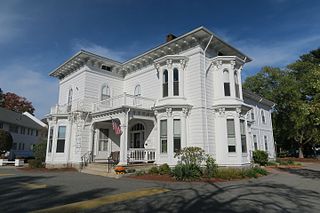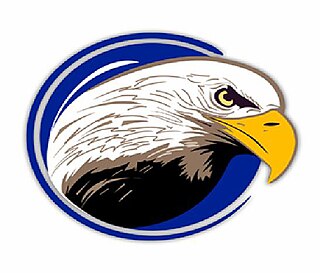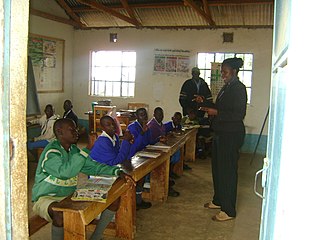
Ángel Ramos is current Principal of Hawaii School for the Deaf and the Blind. He was the founder of the National Hispanic Council of the Deaf and Hard of Hearing, He was also Former Superintendent of the Idaho School for the Deaf and the Blind, Sequoia School for the Deaf and Hard of Hearing (AZ) and Marie Katzenbach School for the Deaf. He is the second deaf Hispanic/Latino to receive a doctorate degree and the first to receive a doctorate from Gallaudet University.

The Learning Center for the Deaf (TLC) is a Framingham, Massachusetts-based non-profit organization and school serving deaf and hard-of-hearing children and adults.

Indiana School for the Deaf (ISD) is a fully accredited school for the deaf and hard of hearing, located in Indianapolis, Indiana.

Rochester School for the Deaf (RSD) is a private, tuition-free school for deaf and hard of hearing students to attend in Rochester, New York. It is one of the oldest and most respected preK-12th grade schools for children with hearing loss and their families in the United States, and one of nine such school in the state of New York. Serving the Central and Western portions of New York State, it has been educating students since 1876.

The Ernest C. Drury School for the Deaf is a provincial school in Milton, Ontario, Canada with residential and day programs serving elementary and secondary deaf and hard-of-hearing students.

Marlton School is a KG–12 public special school for the deaf and hard of hearing students in Los Angeles, California, United States. It was established in 1968 and is part of the Los Angeles Unified School District.
The Wyoming School for the Deaf was a school for deaf elementary students located in Casper, Wyoming, United States. The school was open from 1961 until it was closed due to a lack of students in 2000. The school was created to accommodate the concerns of parents who did not want to send their deaf children to schools in other states. Early pilot programs were conducted, and in 1959, a house was purchased across from the local Pineview Elementary School and used to house the program. In 1961, the state legislature appropriated more funds for the program and a permanent school was built and dedicated in 1963.

Deaf education is the education of students with any degree of hearing loss or deafness. This may involve, but does not always, individually-planned, systematically-monitored teaching methods, adaptive materials, accessible settings, and other interventions designed to help students achieve a higher level of self-sufficiency and success in the school and community than they would achieve with a typical classroom education. There are different language modalities used in educational setting where students get varied communication methods. A number of countries focus on training teachers to teach deaf students with a variety of approaches and have organizations to aid deaf students.

The Sir James Whitney School for the Deaf is a provincial school in Belleville, Ontario with residential and day programs serving elementary and secondary deaf and hard-of-hearing students.
The Manitoba School for the Deaf is a provincial school in Winnipeg, Manitoba with both residential and day programs serving deaf and hard-of-hearing students.
The Alberta School for the Deaf is a provincial school in Edmonton, Alberta with elementary and secondary residential and day programs serving deaf and hard-of-hearing students.

The British Columbia School for the Deaf is a provincial school in Burnaby, British Columbia with day programs serving deaf and hard-of-hearing students. The school teaches secondary students. It shares a campus with Burnaby South Secondary School, for hearing students, serving around 50 students.
The Robarts School for the Deaf is a provincial school in London, Ontario, with residential and day programs serving elementary and secondary deaf and hard-of-hearing students.
The MacKay School for the Deaf is a provincial school in Montreal, Quebec, Canada with day programs serving deaf and hard-of-hearing students.
Iowa School for the Deaf is a pre-K to 12th grade school for deaf and hard-of-hearing students located in Council Bluffs, Iowa. It serves students who live in Iowa and Nebraska.
The history of deaf education in the United States began in the early 1800s when the Cobbs School of Virginia, an oral school, was established by William Bolling and John Braidwood, and the Connecticut Asylum for the Deaf and Dumb, a manual school, was established by Thomas Hopkins Gallaudet and Laurent Clerc. When the Cobbs School closed in 1816, the manual method, which used American Sign Language, became commonplace in deaf schools for most of the remainder of the century. In the late 1800s, schools began to use the oral method, which only allowed the use of speech, as opposed to the manual method previously in place. Students caught using sign language in oral programs were often punished. The oral method was used for many years until sign language instruction gradually began to come back into deaf education.
The Alaska State School for the Deaf and Hard of Hearing is a public school located in Anchorage, Alaska, United States.
Kendall Demonstration Elementary School (KDES) is a private day school serving deaf and hard of hearing students from birth through grade 8 on the campus of Gallaudet University in the Trinidad neighborhood of Washington, D.C. Alongside Model Secondary School for the Deaf, it is a federally funded, tuition-free demonstration school administered by the Laurent Clerc National Deaf Education Center at Gallaudet University.
Nicaragua's total population is 6,000,000, but a reliable count of the number of deaf people in Nicaragua is difficult to obtain. In 2009, a law was passed in which Nicaraguan Sign Language (NSL) was named as the official language of deaf people in Nicaragua. NSL is a newer sign language that emerged less than 50 years ago when deaf children started attending school. Due to the country's lack of early childhood hearing screenings, hearing loss is often undetected and left untreated. Deaf and hard-of-hearing children often face language deprivation due to the lack of language input they experience until they enter school. There are many schools in different cities in Nicaragua; however, the majority of deaf children throughout the country are not attending school. Deaf and hard-of-hearing people also face struggles when finding employment opportunities. NSL isn't an endangered sign language, but the total number of people who use the language are under 10,000.

Carter Churchill was a Canadian elementary school student when he and his parents', Todd and Kim Churchill successfully challenged the Newfoundland and Labrador English School District, (NLEDS), with a Canadian human rights tribunal claiming that Carter, who is deaf, was being discriminated against by not having access to a full time American Sign Language (ASL) interpreter, while in the classroom.










